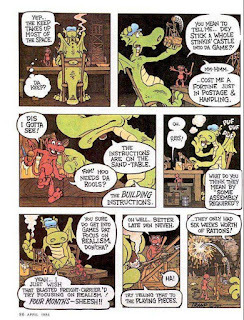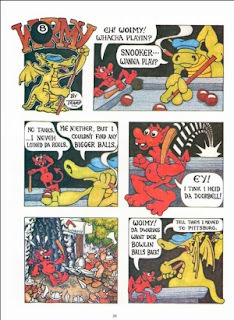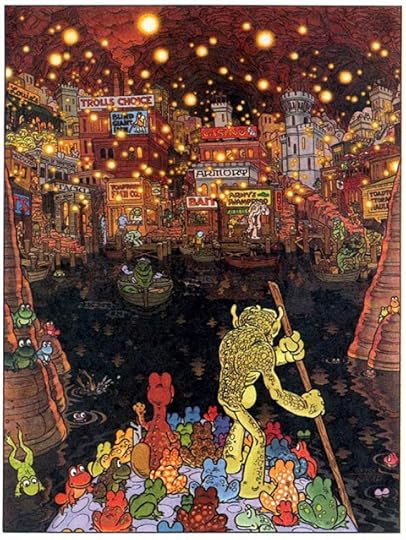Smoke Rings and Sorcery: An Ode to Wormy
 Among the many delights of flipping through issues of Dragon magazine from my youth is getting the chance to see Dave Trampier's Wormy comic strip once again. Long before I was conscious of the names of any of the artists who appeared in my favorite RPG products, I knew Wormy. Even among the clutter of rules variants, advertisements, fiction, and the occasionally bombastic editorials that defined Dragon during the years when I most avidly read it, Wormy stood out, in large part because it was so strange. It was a peculiar, beautiful little world unto itself, filled with pool-playing dragons, cigar-chomping ogres, and an imp who spoke with the laid-back confidence of a veteran hustler. It was, in short, utterly unlike anything else in the pages of Dragon and it fascinated me – in large part because I didn't fully understand it or its continuing storyline, having picked it up many issues after it first began.
Among the many delights of flipping through issues of Dragon magazine from my youth is getting the chance to see Dave Trampier's Wormy comic strip once again. Long before I was conscious of the names of any of the artists who appeared in my favorite RPG products, I knew Wormy. Even among the clutter of rules variants, advertisements, fiction, and the occasionally bombastic editorials that defined Dragon during the years when I most avidly read it, Wormy stood out, in large part because it was so strange. It was a peculiar, beautiful little world unto itself, filled with pool-playing dragons, cigar-chomping ogres, and an imp who spoke with the laid-back confidence of a veteran hustler. It was, in short, utterly unlike anything else in the pages of Dragon and it fascinated me – in large part because I didn't fully understand it or its continuing storyline, having picked it up many issues after it first began.
 Wormy's debut (in issue #9, September 1977) occurred when Dragon was still very much in its formative years. Indeed, the hobby of roleplaying itself was barely out of its own infancy and TSR’s flagship magazine was still trying to figure out what kind of publication it wanted to be. Early issues mixed game material with essays, fiction, and humor. Comics became a regular feature before long, with J.D. Webster's Finieous Fingers being one of the more well-known of the bunch, even though it ended its run about a year before I started reading Dragon. But Wormy stood out as something different. It was never simply an in-joke for gamers nor a gag strip loosely inspired by fantasy tropes. Instead, it presented a fully realized fantasy world rendered in lush color and with a distinct artistic sensibility.
Wormy's debut (in issue #9, September 1977) occurred when Dragon was still very much in its formative years. Indeed, the hobby of roleplaying itself was barely out of its own infancy and TSR’s flagship magazine was still trying to figure out what kind of publication it wanted to be. Early issues mixed game material with essays, fiction, and humor. Comics became a regular feature before long, with J.D. Webster's Finieous Fingers being one of the more well-known of the bunch, even though it ended its run about a year before I started reading Dragon. But Wormy stood out as something different. It was never simply an in-joke for gamers nor a gag strip loosely inspired by fantasy tropes. Instead, it presented a fully realized fantasy world rendered in lush color and with a distinct artistic sensibility.What immediately set Wormy apart was, of course, Trampier’s art. Nowadays, we all celebrate Trampier from his iconic work on the AD&D Player’s Handbook and the Dungeon Master’s Screen. His style is clean, expressive and rich in texture and character. Wormy carried those same qualities into serialized comic form, but with an added flourish of visual wit and playfulness. The strip was never slapdash or haphazard. Trampier’s panels were packed with detail, his character designs expressive, his linework confident. Each page was a feast for the eyes and even when the plot meandered a bit (as it regularly did), the visuals carried the reader along to such an extent that he didn't care. I know I didn't, even though, as I said, it wasn't always clear to my younger self just what was happening in many installments.
 The tone of the strip is one of its greatest charms. Wormy is unquestionably fantasy, but it’s fantasy as seen through a haze of cigar smoke and the low hum of a barroom pool table. Its characters speak in a colloquial American idiom that lends the strip a grounded, personable quality. One never gets the sense that Wormy or Ace or the ogres and trolls with whom he shares his world are interested in epic quests or noble deeds. They’re more likely to be plotting a scam, hustling a demon, or arguing about who’s buying the next round. This sense of the fantastical-as-everyday-life gives Wormy much of its charm and humor, not to mention its distinctiveness from the other comics that appeared alongside it in Dragon.
The tone of the strip is one of its greatest charms. Wormy is unquestionably fantasy, but it’s fantasy as seen through a haze of cigar smoke and the low hum of a barroom pool table. Its characters speak in a colloquial American idiom that lends the strip a grounded, personable quality. One never gets the sense that Wormy or Ace or the ogres and trolls with whom he shares his world are interested in epic quests or noble deeds. They’re more likely to be plotting a scam, hustling a demon, or arguing about who’s buying the next round. This sense of the fantastical-as-everyday-life gives Wormy much of its charm and humor, not to mention its distinctiveness from the other comics that appeared alongside it in Dragon. In this, Wormy mirrors the culture of early roleplaying itself. The early hobby, as reflected in the pages of Dragon, was a strange admixture of wargamers, fantasy and science fiction fans, history buffs, and countercultural weirdos. This was a time before fantasy had hardened into genre orthodoxy, when anything could happen and often did. The world Trampier presented in Wormy feels like a campaign gone delightfully off the rails: a sandbox setting where the players long ago stopped caring about the dungeon and are now embroiled in a decades-long tavern brawl. For me, that was a big part of what I found so compelling about Wormy. It was so unlike my then-narrow conception of "fantasy" that I couldn't help but keep reading.
Over time, Trampier introduced a larger story into the strip. There were plots and schemes in motion and strange characters lurking just out of frame. Readers were teased with glimpses of the larger world beyond Wormy’s abode and the smoky dens of the trolls. Then, just as suddenly as it had begun, Wormy vanished. Trampier’s final installment appeared in Dragon #132 (April 1988), ending mid-story. He never offered a public explanation. Other than the following, which appeared in issue #136 (August 1988), TSR never provided an explanation for what had happened:
 Wormy, along with its creator, David Trampier, vanished without a trace.
Wormy, along with its creator, David Trampier, vanished without a trace.This abrupt disappearance only deepened the comic strip’s allure. In the years that followed, fans spun wild theories: Was Trampier dead? Had he severed all ties with the gaming world? Or was it something darker? For decades, the mystery endured, unanswered. Then, in 2002, word emerged that Trampier was alive, living a quiet life in southern Illinois as a taxi driver. He had steadfastly declined all invitations to return to art or gaming until 2014, when he agreed to showcase some of his original artwork at a local Illinois game convention. Tragically, just three weeks before the event, he died suddenly at age 59.
 In hindsight, Wormy feels like a microcosm of an entire era in fantasy gaming, a time that was raw, personal, and unapologetically chaotic. The strip was a labor of love, brimming with anarchic energy, improvisational flair, and unfiltered creativity. Like the Dragon magazine of its heyday, Wormy was gloriously messy, fiercely idiosyncratic, and utterly brilliant in its refusal to conform or explain itself.
In hindsight, Wormy feels like a microcosm of an entire era in fantasy gaming, a time that was raw, personal, and unapologetically chaotic. The strip was a labor of love, brimming with anarchic energy, improvisational flair, and unfiltered creativity. Like the Dragon magazine of its heyday, Wormy was gloriously messy, fiercely idiosyncratic, and utterly brilliant in its refusal to conform or explain itself.As the hobby grows ever more polished and commercialized, Wormy stands as a vibrant reminder of its roots, a time when oddballs and iconoclasts like Trampier defined its spirit. More than a relic, Wormy embodies the untamed passion and fearless imagination of those who dared to be unapologetically strange. It captures a moment when the heart of gaming pulsed with individuality, free from the gloss of corporate agendas.
Whenever I leaf through old issues of Dragon, I find myself missing Wormy – not just the comic, but what it stood for: the spirit of unfiltered creativity, the joy of irreverence, and the beautiful imperfections of a world made by and for dreamers. In remembering Wormy, we remember that the true magic of roleplaying lies not in polished production values or grand designs, but in the bold, eccentric, and often messy adventures we undertake with one another .

James Maliszewski's Blog
- James Maliszewski's profile
- 3 followers



